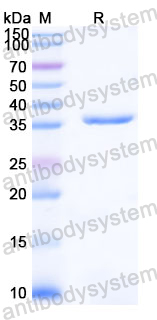Catalog No.
YHG47201
Expression system
E. coli
Species
Homo sapiens (Human)
Protein length
Gln204-Val277
Predicted molecular weight
36.06 kDa
Nature
Recombinant
Endotoxin level
Please contact with the lab for this information.
Purity
>90% as determined by SDS-PAGE.
Accession
Q13286
Applications
ELISA, Immunogen, SDS-PAGE, WB, Bioactivity testing in progress
Form
Lyophilized
Storage buffer
Lyophilized from a solution in PBS pH 7.4, 0.02% NLS, 1mM EDTA, 4% Trehalose, 1% Mannitol.
Reconstitution
Reconstitute in sterile water for a stock solution. A copy of datasheet will be provided with the products, please refer to it for details.
Shipping
In general, proteins are provided as lyophilized powder/frozen liquid. They are shipped out with dry ice/blue ice unless customers require otherwise.
Stability and Storage
Use a manual defrost freezer and avoid repeated freeze thaw cycles. Store at 2 to 8°C for frequent use. Store at -20 to -80°C for twelve months from the date of receipt.
Alternative Names
BTS, Battenin, Batten disease protein, Protein CLN3, CLN3
Evidence of the impact of CLN2 and CLN3 Batten disease on families in the United Kingdom., PMID:40355884
Genetic Reasons for Phenotypic Diversity in Neuronal Ceroid Lipofuscinoses and High-Resolution Imaging as a Marker of Retinal Disease., PMID:40206986
Purifying and profiling lysosomes to expand understanding of lysosomal dysfunction-associated diseases., PMID:39959975
Speech, Language and Non-verbal Communication in CLN2 and CLN3 Batten Disease., PMID:39821609
2024 Scholars' Research Symposium Abstract: Sex-Split Analysis of Pathology and Motor-Behavioral Outcomes in a Mouse Model Of CLN8-Batten Disease., PMID:39820909
Tagless LysoIP for immunoaffinity enrichment of native lysosomes from clinical samples., PMID:39724071
Phenotypic variability observed in a Chinese patient cohort with biallelic variants in the CLN genes., PMID:39563673
Extending the G1 phase improves the production of lipophilic compounds in yeast by boosting enzyme expression and increasing cell size., PMID:39536088
Genetic and Cellular Basis of Impaired Phagocytosis and Photoreceptor Degeneration in CLN3 Disease., PMID:39535788
Loss of CLN3 in microglia leads to impaired lipid metabolism and myelin turnover., PMID:39438652
Oncological Aspects of Lysosomal Storage Diseases., PMID:39404425
CLN3 transcript complexity revealed by long-read RNA sequencing analysis., PMID:39367445
Six induced pluripotent stem cell lines from fibroblasts of individuals with CLN3-related conditions., PMID:39317061
Increased SNAI2 expression and defective collagen adhesion in cells with pediatric dementia, juvenile ceroid lipofuscinosis., PMID:39154552
The dopamine analogue CA140 alleviates AD pathology, neuroinflammation, and rescues synaptic/cognitive functions by modulating DRD1 signaling or directly binding to Abeta., PMID:39129007
TRPML1 activation ameliorates lysosomal phenotypes in CLN3 deficient retinal pigment epithelial cells., PMID:39080379
Upregulation of peroxisome proliferator-activated receptor γ with resorcinol alleviates reactive oxygen species generation and lipid accumulation in neuropathic lysosomal storage diseases., PMID:39038642
Loss of the lysosomal protein CLN3 modifies the lipid content of the nuclear envelope leading to DNA damage and activation of YAP1 pro-apoptotic signaling., PMID:38853929
Translational control of MPS1 links protein synthesis with the initiation of cell division and spindle pole body duplication in Saccharomyces cerevisiae., PMID:38713088
A recessive CLN3 variant is responsible for delayed-onset retinal degeneration in Hereford cattle., PMID:38516801
The parent and family impact of CLN3 disease: an observational survey-based study., PMID:38500130
DYT-THAP1: exploring gene expression in fibroblasts for potential biomarker discovery., PMID:38498291
Glycerophosphodiesters inhibit lysosomal phospholipid catabolism in Batten disease., PMID:38447580
Short peptides based on the conserved regions of MIEN1 protein exhibit anticancer activity by targeting the MIEN1 signaling pathway., PMID:38272230
Developmental Skills and Neurorehabilitation for Children With Batten Disease: A Retrospective Chart Review of a Comprehensive Batten Clinic., PMID:38242022
Evidence for novel mechanisms that control cell-cycle entry and cell size., PMID:38231863
CLN3 deficiency leads to neurological and metabolic perturbations during early development., PMID:38195117
Assessing the integrity of auditory sensory memory processing in CLN3 disease (Juvenile Neuronal Ceroid Lipofuscinosis (Batten disease)): an auditory evoked potential study of the duration-evoked mismatch negativity (MMN)., PMID:38183037
Fluorescence Correlation Spectroscopy as a Versatile Method to Define Aptamer-Protein Interactions with Single-Molecule Sensitivity., PMID:38124657
Construction and validation of a novel lysosomal signature for hepatocellular carcinoma prognosis, diagnosis, and therapeutic decision-making., PMID:38114725
Acidified drinking water improves motor function, prevents tremors and changes disease trajectory in Cln2R207X mice, a model of late infantile Batten disease., PMID:37932327
Multimodal and longitudinal evaluation of novel phenotype-genotype correlation of CLN3 isolated retinal degeneration in an hispanic female with heterozygous mutations c.944dup and c.1305C>G., PMID:37621118
Hyperactive Ras disrupts cell size control and a key step in cell cycle entry in budding yeast., PMID:37531631
Loss of the batten disease protein CLN3 leads to mis-trafficking of M6PR and defective autophagic-lysosomal reformation., PMID:37400440
Protracted CLN3 Batten disease in mice that genetically model an exon-skipping therapeutic approach., PMID:37359347
Cerebrospinal Fluid Protein Biomarker Discovery in CLN3., PMID:37338096
A novel porcine model of CLN3 Batten disease recapitulates clinical phenotypes., PMID:37305926
Juvenile CLN3 disease is a lysosomal cholesterol storage disorder: similarities with Niemann-Pick type C disease., PMID:37245481
Enhanced expression of the autophagosomal marker LC3-II in detergent-resistant protein lysates from a CLN3 patient's post-mortem brain., PMID:37209872
Brain proton MR spectroscopy measurements in CLN3 disease., PMID:37086568
A mouse mutant deficient in both neuronal ceroid lipofuscinosis-associated proteins CLN3 and TPP1., PMID:37078466
Clinical and genetic characterization of neuronal ceroid lipofuscinoses (NCLs) in 29 Iranian patients: identification of 11 novel mutations., PMID:37074398
Recognition and epileptology of protracted CLN3 disease., PMID:37039534
Bioinformatics analysis and experimental validation of a novel autophagy-related signature relevant to immune infiltration for recurrence prediction after curative hepatectomy., PMID:37014321
The Batten disease protein CLN3 is important for stress granules dynamics and translational activity., PMID:36965618
Early recognition of CLN3 disease facilitated by visual electrophysiology and multimodal imaging., PMID:36964447
Phenotypic Variability of Retinal Disease Among a Cohort of Patients With Variants in the CLN Genes., PMID:36912596

